and historical purposes, all rights reserved.
This page is copyright© by
This page may not be sold or distributed without the
expressed permission of the producer
On-line camera manual library
This is a typical K-mount Chinon,
Sears or Ricoh type camera.
This camera manual library is for reference
and historical purposes, all rights reserved.
This page is copyright© by ![]() , M. Butkus, NJ.
, M. Butkus, NJ.
This page may not be sold or distributed without the
expressed permission of the producer
On-line camera manual library
If you find this manual
useful,
how about a donation of $3 to:
M. Butkus, 29 Lake Ave.,
High Bridge, NJ 08829-1701
and send your
e-mail address
so I can thank you.
Most other places would charge
you $7.50 for a electronic copy
or $18.00 for a hard to read Xerox copy.
If you use Pay Pal, use the link below.
Use the above address for a check, M.O. or cash.
Problems
opening PDF files or printing problems
- click here
Back to my main Camera manual page
Click here for
Sears KS-2 PDF
version made from HTML - better printing

CONGRATULATIONS!
You have just purchased a fine camera that will give you many years of picture-taking pleasure. The KS-2 is a 35 mm SLR camera which assures you of superb optics. outstanding mechanical performance and reliability which will justify your choice for years to come.
Before using your KS-2
Please read this instruction booklet carefully and familiarize yourself with the equipment and its features thoroughly. Your pleasure in using your KS-2 will be greater if you know your camera properly.
DESCRIPTION OF PARTS
 |
1. Shutter Speed Index Line 2. Shutter Speed Dial Release Button 4. Shutter Speed Dial 5. Film Advance Lever 6. Exposure Counter 7. Depth of Field Preview Lever 8. Strap Eyelet 9. Self-Timer Indicator Light 10. Exposure Indication Switch 11. Lens Release Lever |
 |
12. Lens Mounting Locator Node 13. Flash Synchro Terminal 14. Focusing Ring 15. Distance Scale 16. Depth of Field Scale 17. F-Stop Ring 18. AE Lock Button 19. Aperture Relay Window 20. Film Speed Index Line 21. Film Speed Dial
|
|
22. Film Rewind Knob (Back Cover Lock Release Knob) 23. Film Rewind Crank 24. Exposure Adjustment Dial 25. Self-Timer Switch 26. Exposure Adjustment Index Line 27. Hot Shoe 28. Flash Ready Signal Contact 29. Viewfinder Eyepiece 30. Film Rewind Shaft 31. Film Chamber 32. Battery Compartment Cover
|
33. Tripod Socket 34. Winder Contact 35. Film Rewind Release Button 36. Winder Coupler 37. Winder Positioning Hole 38. Film Pressure Plate 39. Back Cover 40. ASA/DIN Conversion Table 41. Film Take-up Spool 42. Sprocket 43. Multiple Exposure Button 44. Multiple Exposure Lock Switch |
SPECIFICATIONS: Sears KS-2
TYPE ..... 35 mm SLR with automatic electronic exposure control focal plane shutter
FILM FORMAT AND FRAME SIZE........... 35 mm film: 24 x 36 mm
LENS MOUNT........................................... K mount
STANDARD LENSES................................. 50 mm AUTO SEARS f/1.4 (Multi-coated)
50 mm AUTO SEARS f/1.7 (Multi-coated)
50 mm AUTO SEARS f/2.0 (Coated)
SHUTTER .......... Electronically controlled, vertically moving metal focal plane shutter Automatic from 16 to 1/1000 sec. Manual from 16 to 1/1000 sec. plus B
SELF-TIMER ............ Operating delay about 10 seconds during operation the red LED light pulsates and an electronic sound is emitted.
VIEWFINDER ....... Field of view covers 93% horizontally and vertically Viewing Magnification 0.88X (with 50 mm f/1.4 lens) Indicators in the viewfinder— Exposure Adjustment. Bulb, Manual, Overexposure, Underexposure, Shutter Speeds. Slow Shutter, Long Time Exposure, Battery Low Warning, Flash Ready LED Light, F-Stop Number, AE Lock.
FOCUSING .............................. Split-image spot in microprism band
EXPOSURE METER .................... TTL full open metering for center-weighted average
light reading coupled automatically to f-stop.
EXPOSURE COUPLING RANGE... EV 0 - EV 18 (with ASA 100 film 50 mm f/1.4 lens)
FILM SPEED RANGE..................ASA 12 - 3200
FLASH TERMINAL........ X synchro contact
ACCESSORY SHOE...................................Hot Shoe (with Flash Ready Signal Contact) Flash Synchro Terminal EXPOSURE ADJUSTMENT...... Exposure adjustment system (+2 ~ - 2. in 1/3 steps) AE Lock System (Memory)
FILM ADVANCE..........Single stroke film advance lever with 135° winding angle and 35° stand-off Automatic winding possible by mounting Sears Autowinder
EXPOSURE COUNTER......Additive, automatic resetting
FILM REWIND.................... Film Rewind Crank System
MIRROR ................ Quick return mirror
BACK COVER...... Hinged type. opened by pulling up Film Rewind Knob
POWER SOURCE................(Mallory MS76, Eveready S76 or equivalent) Two SR-44 1.55V Silver Oxide batteries; or Two LR-44 1.5V Alkaline batteries
DIMENSIONS ...................5.4" (W) x 3,4N (H) x 2.0" (D) (body only)
WEIGHT...........................16.6 oz (body only)
WEIGHT OF STANDARD LENSES...........
50 mm f/1.4 9.2 oz 50 mm f/1.7 7.4 oz
50 mm f/2 4.9 oz
1. ATTACHING THE VIEWFINDER CAP AND STRAP
 |
Viewfinder Cap For instructions on how to use the Viewfinder Cap. read the section on Self-Timer Photography and Usage of the Viewfinder Cap. 1. Attach the Viewfinder Cap to the strap. 2. Put the strap through the Strap Eyelet and adjust it to the correct length.
|
2. CHANGING LENSES
To Remove the Lens from the Camera
 |
1. Line up the red dot on the lens mount with the matching red dot on the camera body. or alternatively. match the red (dot) mark on the Depth of Field Scale to the red dot on the camera body.
* For convenience when mounting the lens in the dark. you can line up the Lens Mounting Locator Node with the Lens Release Lever. * Since the body cap has the same mount as the lens. You can remove or mount lens cap in the same way as the lens.
|
3. INSERTING THE BATTERIES
 |
The exposure metering and shutter operation of this camera are powered by batteries, so it is important to insert the batteries correctly for correct operation. 1. Remove the Battery Compartment Cover by turning it counterclockwise with a coin. 2. Place the two batteries on top of each other as shown in the illustration on the battery holder of the Battery Compartment Cover.
|
Batteries for the KS-2 [NOTE: click here for a listing of most Chinon Camera Batteries]
Two LR-44 Alkaline batteries; life-span about 6 months; or two SR-44 Silver Oxide batteries; life-span about 12 months.
* Since dirt or sweat on the batteries may cause a bad contact, wipe the batteries clean with a dry cloth before inserting them.
* When your camera is not used for a long period of time, remove the batteries.
* If no batteries are inserted, if they are incorrectly inserted, or if they are worn out, the camera will not operate. Check that the batteries are correctly inserted, and if they are and the camera does not operate, replace them with new batteries.
* When the voltage of the batteries is getting low, the BAT (Battery Low Warning Signal) in the Viewfinder will blink on and off.
4. INSERTING THE FILM
 |
(Always avoid direct sunlight when inserting the film.)
|
 |
2. Insert the film in the Film Chamber and push the Film Rewind Knob down to its former position.
3. Insert the film leader into the slit on the Film Take-up Spool. 4. Advance the film, making sure that the sprocket holes on the film are fully engaged on the Sprocket Teeth. 5. Close and press the Back Cover firmly to lock it. Pull up the Film Rewind Crank and turn it gently in the direction of the arrow until the slack in the film has been taken up. 6. Advance the film and press the Shutter Release Button a few times until the number "1" appears in the Exposure Counter. As you advance the Film Advance Lever, the Film Rewind Knob rotates indicating that the film is properly advanced.
|
 |
* When inserting the film, it is more convenient to set the Shutter Speed Dial to a high speed rather than A (Auto) for advancing the film to the number "1" position, to avoid firing and waiting for a slow shutter speed to finish (the slowest is 16 seconds). When you are ready for shooting, be sure to set the Shutter Speed Dial back to A (Auto). * When inserting the film in cold conditions, the Film Leader may become hard and brittle. Keep it warm in your hand before insertion, and insert it quickly.
|
5. SETTING THE FILM SPEED
 |
The film speed is the basic element for determining the exposure, so please be sure to set the film speed correctly.
|
6. EXPOSURE INDICATION SWITCH
When you press the Exposure Indication Switch, the liquid crystal indication of shutter speed, will appear in the Viewfinder. After shooting, the power source will cut off automatically after 8 minutes in order to preserve the life of the batteries.
 |
7. VIEWFINDER INFORMATION 1. Microprism Band 2. Split-image Spot 3. Shutter Speeds 4. F-Stop Number 5. Exposure Adjustment 6. Bulb 7. Manual 8. Overexposure 9. Shutter Speed Indicator (pulsates when on AE lock) 10. Slow Shutter 11. Long Time Exposure 12. Underexposure 13. Battery Low Warning Signal 14. Flash Ready LED Light |
The Shutter Speed, Slow Shutter and Long Time Exposure indications are always present in the viewfinder. The parts indicated by the liquid crystal show the information relative to a particular moment.
 |
PHOTOGRAPHY (NOTE FROM MIKE B. - This is will apply to any Chinon, Pentax or Ricoh automatic camera) Your KS-2 camera enables you to use automatic exposure where the shutter speed is automatically selected, or manual exposure where you may select the shutter speed yourself. [NOTE: Mike B. - The shutter speed is chosen by the meter reading what the lens F-stop is set too at that time. Change the F-stop and a different shutter speed will be chosen.]
|
 |
Press the front button to turn on the metering system (most cameras have the meter only stay on for a few minutes. Other brands require you to just gently press the shutter button to activate the meter system.) |
1. Set the "A" on the Shutter Speed Dial against the Shutter Speed Index Line.
4. When the Shutter Speed Indicator is within the orange band. this means a slow shutter speed. You should either select a different f-stop setting. or pay particular attention to camera shake.
5. When the (up triangle) Overexposure mark or the (down triangle) Underexposure mark appears, you should select another f-stop number, as the exposure is incorrect.
| Lighting Conditions | F-stop number range |
| Indoors Outdoors, cloudy Outdoors, sunshine Beach in mid-summer and snow scenes |
F/2 - F2.8 F4 - F5.6 F8 - F11 F11 - F16 |
With film speed ASA 100
9. MANUAL PHOTOGRAPHY
 |
1. Press the Shutter Speed Dial Release Button. and set the Shutter Speed Dial to the desired shutter speed. |
 |
2. The letter "M" in the Viewfinder will pulsate to indicate Manual mode.
|
| Lighting conditions | Shutter speed range |
|
Indoors
Outdoors. cloudy Outdoors, sunshine Beach in mid-summer, snow scenes |
1/30 - 1/60 1/60 - 1/125 1/125 - 1/250 1/250 - 1/1000 |
10. HOLDING THE CAMERA
Holding the camera correctly when shooting is very important.
 |
1. The camera should be positioned on the palm of your left hand so that you can use your fingers to turn the Focusing Ring of the lens easily
2. The index finger of your right hand should rest lightly on the Shutter Release Button, while your right hand holds the camera body lightly. 3. Your right arm should be in a comfortable position. 4. Keep your left arm resting lightly against your body, and the camera should just touch your forehead when you look through the viewfinder. |
* It is important to shoot with the correct body posture, to avoid blurred or tilted shots.
11. FOCUSING
 |
Look through the viewfinder to compose your picture and focus by turning the Focusing Ring. You can focus either by using the center Split-image Spot or the Microprism Image Band that surrounds the center circle. Split-image Focusing When the split image in the Split-image Spot forms a single image, the subject is in focus. Microprism Focusing When the subject loses its "shimmering" effect and becomes very sharp, the subject is in focus. |
12. REWINDING THE FILM
 |
(Always avoid direct sunlight when unloading the film). After the last picture on the roll of film has been taken, rewind the film. 1. Press the Film Rewind Release Button, and it will remain locked into position. 2. Pull up the Film Rewind Crank and turn it in the direction of the arrow. When the film has been completely rewound, the tension of the Film Rewind Crank is released and it will revolve freely. 3. Pull up the Film Rewind Knob to its fullest extent and the Back Cover will open. Remove the film, push the Film Rewind Knob back into position and close the Back Cover. * Never open the Back Cover during rewinding, as light will get in and ruin your film.
|
13. AE LOCK SYSTEM
 |
This camera has an AE Lock system. When shooting against the light on automatic exposure, the contrast in the brightness of the background and the subject means that you cannot obtain a correct exposure of the subject. In this case you should use the AE Lock which retains the exposure of the subject regardless of the changes in the background lighting conditions. The exposure will not change until you cancel the AE Lock.
2. Compose the picture and shoot. The AE Lock is then automatically cancelled. 3. If you wish to cancel the AE Lock before pressing the Shutter Release Button, press the AE Lock Button again.
|
14. EXPOSURE ADJUSTMENT SYSTEM
 |
According to shooting conditions, the camera may be affected more by the background light than the light of the subject itself. This will result in under (or over) exposed pictures. In these cases, you should use the Exposure Adjustment system. You can also use the system when you wish to create a deliberate effect of over (or under) exposure. 1. Turn the Film Exposure Adjustment Dial to set the required number against the Exposure Adjustment Index Line. [NOTE: from Mike B. - Always bracket if you need the shot. Expose a frame over-exposed then another under-exposed and then one the correct exposure according to the meter. This exposure adjustment is tricky and remember to turn the exposure adjustment setting back to 0 (zero) when needed for normal metering. What you are doing is metering, but making the meter think it is darker then it really is and giving the film more light with the + and less light when you set it to a - number]
|
| Subject | Exposure Adjustment |
| Scenery with a lot of sky Figure against the light |
+1 to +2 |
| Figure with a snowscape or seascape background |
+ 1 |
| Spot-lit figure | —1 to —2 |
| * The Exposure Adjustment Dial can be set to click stop (1/3 steps) between the numbers indicated. | |
* Be sure to set it back to the "O" position after use.
15. B (BULB) SETTING
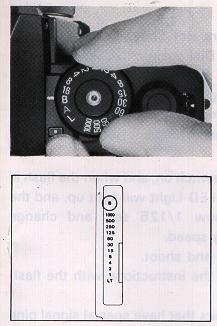 |
The B setting is used for shooting night scenes or long time exposures. 1. Keep the Shutter Speed Dial Release Button pressed down and set the "B" against the Shutter Speed Index Line. The "B" mark in the Viewfinder will pulsate to indicate that the shutter speed is set to B (bulb). 2. When you press the Shutter Release Button, the shutter will remain open as long as the button is pressed. * For long time exposures, use a tripod and cable release to prevent camera shake. [Note: from Mike B. - The self timer can fire off long exposures (1/4 - 16 sec.) without a shutter release cable. For longer exposures a locking cable release is rather cheap and time exposures can give interesting nighttime effects. WARNING: Some electronic shutters (like this camera) use the battery to keep the shutter open. This long exposure can drain the battery big time and could cause you to lose firing ability if the battery dies after a few shots. Keep spare batteries if you do this with an electronic shutter. Spring loaded (manual shutters) are great for long time exposures. Their batteries only power the meter.] |
16. FLASH PHOTOGRAPHY
The Sears Auto/Thyristor electronic flash 48025) is available exclusively for use with this camera. [Note: Mike B. - This is basically a Ricoh camera. A Ricoh dedicated flash will work the auto functions just like this dedicated Sears flash.]
With this flash unit, you can leave the shutter speed set on "A''. Also the Flash Ready red LED light conveniently lights up in the Viewfinder, so that you don't have to take your eye away from the Viewfinder.
[Note: Mike B. - any "automatic" flash (one with an electric eye) can be used with some excellent results. You must set the shutter to 1/125 and the lens aperture to whatever the back of the flash states. Usually you get two or three different F-stops to choose from depending on the flash make, the different F-stops will also state, on the flash unit, the maximum distance you can have to your subject. Usually any F-stop that is allowed can be used just 2 or 3 away also. I usually tape a thin tissue over just the flash tube to diffuse the light for a softer effect when very close. Be careful not to cover that electric eye. Yes, you can shoot at 25 feet @ F/2.8 but the limited "depth of field" can cause you blurry images in front and behind what you focus on. Bigger flash units provide more lighting power and smaller apertures. Many mid size units have bounce and swivel capability for less "deer in the headlights" looks. See my other web pages with tips on flash units. ]
< With the Special Flash Unit >
1. Attach the flash unit to the camera Hot Shoe. Screw it on just snug.
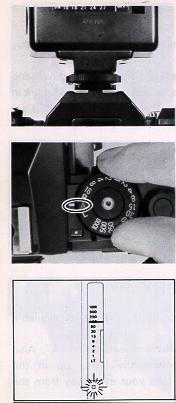 |
2. Set the ''A'' on the Shutter Speed Dial against the Shutter Speed Index Line.
3. Set the f-stop number to the designated exposure for automatic shooting. The flash unit will automatically control the amount of light for subjects within the distance range for automatic flash photography. [NOTE: Mike B. - some flash units have only one "auto" F-stop setting, some provide 3 or 4 different F-stops by adjusting switches on the flash unit. See the users manual of the flash unit] 4. Turn the flash unit's power source switch on, and when the flash is fully charged, the Flash Ready red LED Light will light up and the Shutter Speed Indicator will show 1/125 sec. and change automatically to the synchronizing speed. 5. Press the Shutter Release Button and shoot.
|
* For further details. please refer to the instructions with the flash unit.
* Do not use other makes of flash units that have special signal pins exclusively for their cameras. as this will result in incorrect exposure and may damage the circuitry of the camera.
* If the Shutter Release Button is pressed before the Flash Ready LED Light lights up, the shutter speed will be the one indicated by the Shutter Speed Indicator.
[NOTE: Mike B. - Wait for the ready light or you will get underexposed and most likely extremely blurry images as the shutter will remain open in the dim light.]
17. FLASH PHOTOGRAPHY
With Flash Units Other than the Sears Auto/Thyristor (8025)
1. Set the Shutter Speed Dial to the synchronizing speed of 1/125 sec. 2. The guide number is indicated on the flash unit. Use the guide number in the following equation to obtain the f-stop number and set that number to the f-stop index line.
For example. with a flash unit with guide number 40 for ASA 25, and camera-to-subject distance of 5 feet:
f-stop number (8) = Guide number (40)
--------------------------
Camera-to-subject distance 5 feet
With automatic flash units, set the f-stop number designated for automatic flash photography.
* When using other automatic flash units, please follow the instructions with the flash unit.
Order for Multiple Exposure
Multiple exposure is a device to put more than one exposure into the same frame.
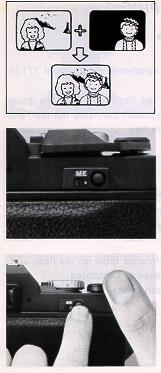 |
[NOTE: Mike B. If you really want to try this, gently rewind the rewind knob to tighten the film, then follow the instructions below. Remember, you must divide the number of shots by your exposure. e.g. for two exposures stop down one full stop (half the amount of light) after finding the correct metering for each picture. This is due to the fact you are adding light to each shot from the previous shot.] 1. Press the Shutter Release Button to obtain the first exposure. 2. Slide the ME Lock Lever to the left until the red dot appears. 3. Advance the Film Advance Lever while keeping the ME Button pressed down. 4. Take the second exposure. * Repeat actions 3 and 4. If you wish to continue adding exposures to the frame. At this time, the Exposure Counter will not advance. * Better results can generally be obtained by taking subjects that include a large area of darker parts. |
* When multi-exposure shots are not required. be sure to slide the ME Lock Lever back into position.
* It is better to inform the camera shop that you have taken multiple exposures when you take your film for printing, as sometimes they do not print these pictures, mistaking them for accidental double-exposures.
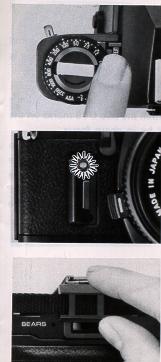 |
USAGE OF THE VIEWFINDER CAP The self-timer enables you to include yourself in your own photographs for commemorative occasions etc. 1. After advancing the film, press the Self-Timer Switch.
3. If you wish to cancel the self-timer once it has started operating, set the Shutter Speed Dial to L (Lock) or B (Bulb). |
Viewfinder Cap
When using the self-timer with the A (Auto) setting, to avoid incident light reversal from the light entering the viewfinder eyepiece and causing incorrect exposure, use the Viewfinder Cap attached to the strap to cover the viewfinder eyepiece.
[NOTE: Mike B. - This item is useful if you are metering those longer shutter speeds (1/4 to 16 sec.) in "Auto" mode as you normally are not looking through the viewfinder. Light from the rear can effect the meter reading.
20. DEPTH OF FIELD
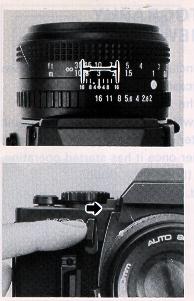 |
When you focus on a specific subject, an area "in front of" and "behind" the subject will appear acceptably sharp in your picture. This area is called the ''Depth of Field". The depth of field can be determined in the following ways:
2. When you press the Depth of Field Preview Lever. it will set the lens diaphragm to the corresponding opening previously set on the F-Stop ring. This enables you to preview the depth of field of the picture.
|
21. INFRARED PHOTOGRAPHY
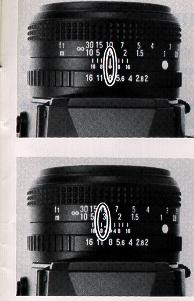 |
The infrared index mark is an index to correct the focusing point when you use (Black & White film) infrared film and red filters. Since infrared light rays have a longer wave-length than visible light rays, after focusing normally on the subject, you have to set that distance against the infrared index mark. Taking Infrared Photographs 1. Attach the red filter and focus on the subject. 2. Shift that distance to the infrared index mark. According to the instructions enclosed with the film, set the f-stop. shutter speed and release the shutter. * Infrared light rays are invisible to the eye and the light meter, so please refer to the instructions with the film for setting the f-stop number and shutter speed. |
22. SPECIAL ACCESSORIES
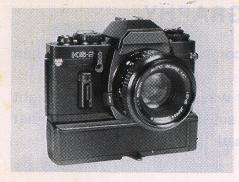 |
If you attach the Sears Autowinder to this camera, the film can be advanced automatically so that you can take continuous shots (2 frames per second). * Before attaching the winder, wipe the contact points on both the camera and the winder with a dry cloth. [NOTE: Mike B. - An eraser on these contact points as well as the contacts on the underside of the camera body can fix problems if the winder does not function due to poor metal to metal contact. |
23. PROPER CARE OF YOUR CAMERA
* Camera malfunction can be caused by shock, humidity, salt air, etc. Avoid using the camera at the beach or in places that use chemicals. Wipe it carefully.
* Do not use chemically-treated dusters to clean the camera.
* Take care not to expose your camera to sudden changes in temperature, as this may cause camera malfunction.
* Do not expose your camera for a long period of time in extremely high temperatures, such as in the back of your car or on a beach, as this may cause camera malfunction.
* When using a tripod. do not try to force a long screw into the socket. (The screw length should be less than 5.7 mm. , JIS 5.5 mm).
* Do not place the camera near equipment that has strong magnetism such as television or radio.
* Remove the batteries before storing the camera. and keep it in a place free of dust and humidity.
* Do not attempt to disassemble or repair your camera yourself. If service is necessary, bring it to the nearest Sears store.